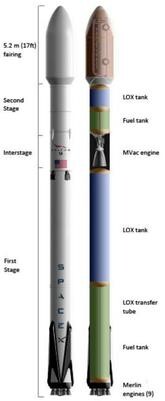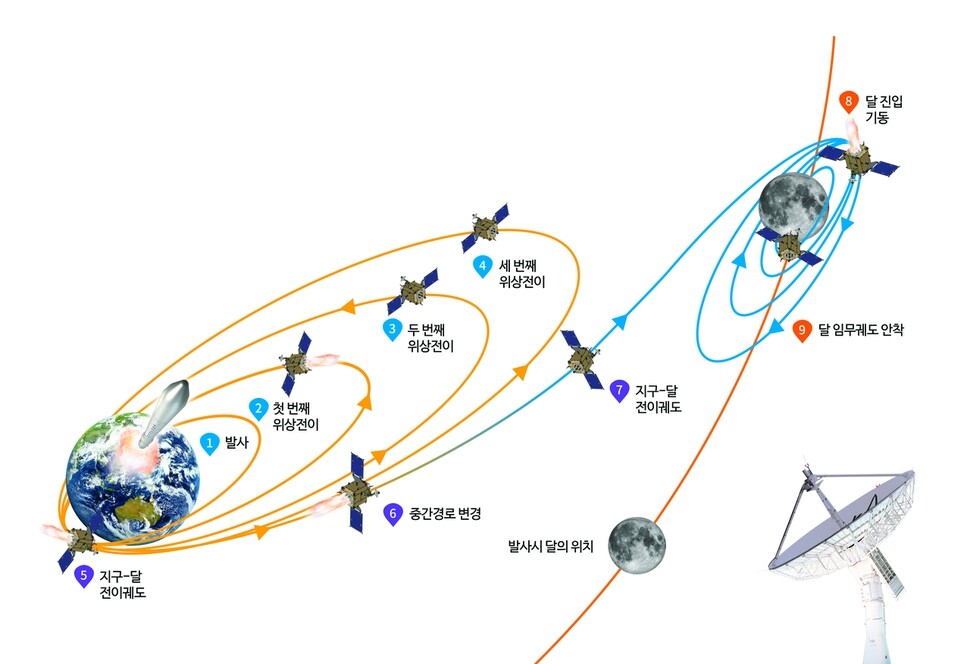hankyoreh
Links to other country sites 다른 나라 사이트 링크
SpaceX selected to assist 2020 South Korean lunar orbiter voyage

A South Korean orbiter to be launched toward the moon in 2020 will be carried on a rocket by the private US aerospace manufacturer SpaceX. “The US company SpaceX has been selected to carry out the scheduled launch of the Korea Pathfinder Lunar Orbiter (KPLO) in 2020, and a launch contract was signed on Dec. 15,” the Korea Aerospace Research Institute (KARI) announced on Dec. 18.

SpaceX and India’s Antrix took part in the overseas bidding to carry out the launch, with KARI selecting SpaceX as a priority negotiation candidate. The final launch contract is determined through negotiations. SpaceX entered the bidding with its Falcon 9 rocket, a launch vehicle weighing 549 tons and measuring 70 meters in length and 3.7 meters in external diameter with a two-stage liquid-propelled engine that is capable of carrying 22.8 tons into low earth orbit, 8.3 tons into geostationary transfer orbit, and 4 tons into Mars transfer orbit. South Korea’s lunar orbiter weighs approximate 550 kg.
For the first stage of its lunar exploration effort, KARI plans to cooperate internationally with the US National Aeronautics and Space Administration (NASA) on development and operation of the KPLO and establish the necessary core technology and an independent base for lunar exploration. The KPLO is to carry a payload of six items, including a domestically developed high-resolution camera, wide-angle polarimetric camera, lunar gamma ray spectrometer, lunar magnetic field scanner, and space internet, along with a shadow camera developed by NASA.
“The KPLO will enter lunar orbit through an independent propulsion system after launch, transmitting high-resolution video and observational data back to earth while in polar orbit around the moon,” KARI explained.

Detailed design is currently under way for the KPLO after completion of a preliminary system design examination in September. Its launch is to take place in 2020 following integrated electrical function testing, structural model testing, and overall flight model assembly and testing.
KARI plans to use the technology acquired through the first-stage lunar orbiter to attempt a second stage of lunar exploration, in which a lunar orbiter and lander are to be launched with a South Korean-developed launch vehicle. Research is under way to acquire the necessary guidance, navigation, and control technology, as well as propulsion system and landing device technology needed for lunar landing.
By Lee Keun-young, senior staff writer
Please direct questions or comments to [english@hani.co.kr]
Caption: An illustration of the Korea Pathfinder Lunar Orbiter (KPLO), scheduled to be launched on a voyage to the moon in 2020. (provided by Korea Aerospace Research Institute)
Caption 2: The SpaceX Falcon 9 rocket. (provided by Korea Aerospace Research Institute)
Caption 3: An illustration of the KPLO’s planned trajectory (provided by Korea Aerospace Research Institute)

Editorial・opinion
![[Column] Has Korea, too, crossed the Rubicon on China? [Column] Has Korea, too, crossed the Rubicon on China?](https://flexible.img.hani.co.kr/flexible/normal/500/300/imgdb/original/2024/0419/9317135153409185.jpg) [Column] Has Korea, too, crossed the Rubicon on China?
[Column] Has Korea, too, crossed the Rubicon on China?![[Correspondent’s column] In Japan’s alliance with US, echoes of its past alliances with UK [Correspondent’s column] In Japan’s alliance with US, echoes of its past alliances with UK](https://flexible.img.hani.co.kr/flexible/normal/500/300/imgdb/original/2024/0419/2317135166563519.jpg) [Correspondent’s column] In Japan’s alliance with US, echoes of its past alliances with UK
[Correspondent’s column] In Japan’s alliance with US, echoes of its past alliances with UK- [Editorial] Does Yoon think the Korean public is wrong?
- [Editorial] As it bolsters its alliance with US, Japan must be accountable for past
- [Guest essay] Amending the Constitution is Yoon’s key to leaving office in public’s good graces
- [Editorial] 10 years on, lessons of Sewol tragedy must never be forgotten
- [Column] A death blow to Korea’s prosecutor politics
- [Correspondent’s column] The US and the end of Japanese pacifism
- [Guest essay] How Korea turned its trainee doctors into monsters
- [Guest essay] As someone who helped forge Seoul-Moscow ties, their status today troubles me
Most viewed articles
- 1[Column] The clock is ticking for Korea’s first lady
- 2After 2 months of delayed, denied medical care, Koreans worry worst may be yet to come
- 3[Column] Has Korea, too, crossed the Rubicon on China?
- 4Samsung barricades office as unionized workers strike for better conditions
- 5All eyes on Xiaomi after it pulls off EV that Apple couldn’t
- 6[Correspondent’s column] In Japan’s alliance with US, echoes of its past alliances with UK
- 7US overtakes China as Korea’s top export market, prompting trade sanction jitters
- 8Hong Se-hwa, voice for tolerance whose memoir of exile touched a chord, dies at 76
- 9[Photo] Smile ambassador, you’re on camera
- 10[Editorial] When the choice is kids or career, Korea will never overcome birth rate woes